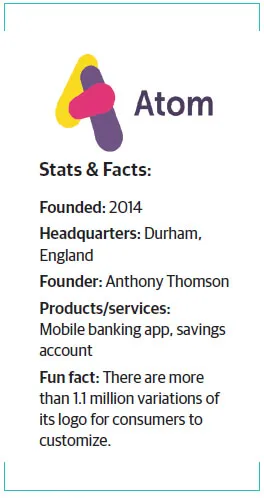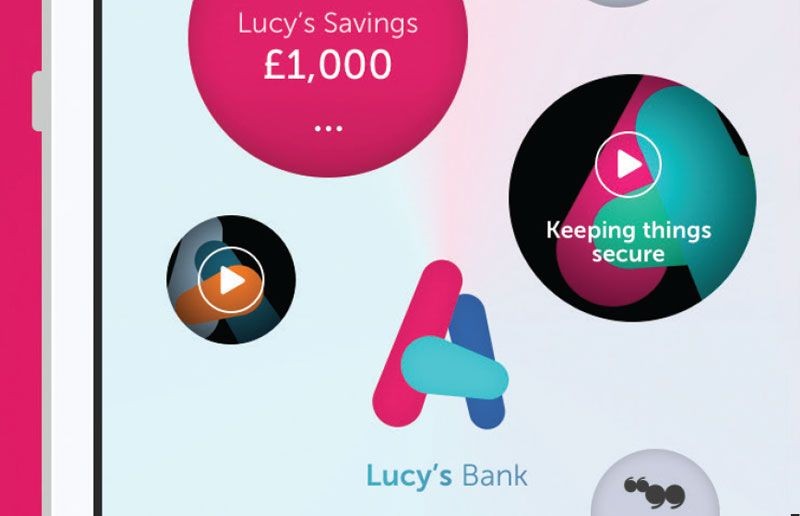Atom Bank is on a mission to challenge the traditional banking model. Its mobile-only platform is distinctly different than what most people think of when they think of banks. Instead of adding mobile channels on top of legacy systems, this bank launched earlier this year in the U.K. with a device-only approach. No branches. Not even web banking tools. Just an app.
“We believe that this segment of customers is completely underserved worldwide,” says Stewart Bromley, Atom’s chief operating officer. “Other banks offer mobile as a channel, but will often push customers to more traditional channels. With Atom, everything happens in the app.”
It turns out, there’s a large market for app-only banking services that’s growing every day. Bromley cites research it conducted two years ago that found that 9 million people in the U.K. were interested in only banking digitally. Based on the growth of the segment and response to user testing, the number is certainly higher now, he says. Echoing this sentiment, Javelin Strategy & Research forecasts that 81 percent of U.S. adults will be using mobile banking by 2020, using a mix of websites and apps.
The topic is a polarizing one, Bromley notes. In a survey of potential customers, 50 percent “absolutely love” the idea of app-only banking. The other 50 percent are apprehensive. “Those most interested were between 25 and 40 years old, but it really is anyone who is comfortable with digital and understands what they want from a bank,” Bromley says. “We have some customers in their 80s.”
Atom is one of a number of apps in the growing fintech space to launch as an alternative to traditional bank leaders. Unlike other apps that focus on a niche part of the banking world, Bromley says Atom considers itself a challenger to the likes of HSBC, Barclays, and other major players.
The bank passed all the regulatory hurdles necessary to do everything a “regular” bank does. It is licensed to offer a full suite of banking services that include consumer savings and lending products, as well as business services. The company launched this spring on Apple iPhones and iPads with a fixed rate savings account and small business loan program. By the end of the year there are plans to roll out current accounts, mortgages, credit cards, and instant access savings. The app will also expand to Android devices, Bromley says, though he declined to share customer numbers or growth targets.
As a mobile bank, nearly all transactions are conducted via electronic transfer. Bromley says that customers soon will be able to use a debit card or check imaging to make deposits and withdraw cash from ATMs. However, “We have no plans to accept cash deposits. We are, after all, a digital bank.”
While it operates as a start-up business with only about 200 employees, banking regulations required that Atom build its cash position before taking on customers. It raised £135 million before commencing operations. Investors include a nearly 30 percent stake by Spain’s BBVA bank. The investment shows the industry’s interest in the mobile-only model and adds credibility to Atom’s platform.
Features leverage mobile’s advantages
Atom’s positioning is that “we use the latest technology to ease your ability to bank,” Bromley says. For example, customers use facial or voice recognition to register and sign into their accounts, with fingerprint authentication in the works. “No usernames, no passwords to remember,” and better security.
Speed is also a big priority. Bromley says the system uses real-time verification with credit and crime bureaus, making for surprisingly quick transactions for those used to the pace of “terrestrial” banking. “You can join the bank and open an account in about five minutes end to end, with no paper or human interaction,” he says, and self-service options are designed from the consumer perspective. He admits that some consumers are wary of the speed, thinking that speedy processes must not be accurate.
And finally, nearly everything about the user experience is personalized. The app is designed with real-time information architecture, which means there is no fixed menu. “We don’t try to cram a whole bank into one screen,” Bromley says. “Depending on what we know about you we use the most relevant, contextual information. Over time, your customer experience will be much different than others.” He says everyone gets the experience they want, which is a major step forward in the banking user experience.

A Millennial business model
The personalization features are not just nice-to-have tools. They align to the company’s values and meet its consumers’ needs. “Our value system is designed around the customer,” particularly around the needs of the Millennial generation, Bromley says. Everything from recruitment and hiring to product development, customer service, and company policies match those values.
One of those values is respect for individuals. Bromley says its research found that most Millennials value uniqueness and individuality. He explains that as a result, the company relinquished control of its brand. The Atom logo was created with 1.1 million variations for users to change. And when you’re in the app, the name that appears is your name—“Stewart’s bank,” instead of Atom Bank. “We’ve taken a brand value and applied it to our core constructs.”
Conventional wisdom says that banking is complicated, and can’t be managed by the customer alone. Atom created its app to buck that notion. Its simple, straightforward language and instructions help build user confidence. Most app customers prefer the channel because they are comfortable with self-service features. Atom’s robust knowledge base is built on artificial intelligence, so as customers use it, the system records common questions and resolutions, and can learn how to give even better answers next time, Bromley says. Next steps include natural language questions, and adding more real-time contextual information into the service platform.
When actual human assistance is needed, Atom has a24x7 in-app chat support desk at the ready. The chat experience happens directly in the app, at the point where you need help. “You don’t have to re-authenticate, and the associate knows where you are in the app and what you are having issues with,” Bromley says. Voice support is available as an external feature, but Bromley says there are plans to add in-app voice and video support by next year.
A trustable approach to data
Because Atom has a personalized, self-service model built on contextual information, data obviously drives much of the company’s operations. Bromley is keenly aware of that, and takes an almost Hippocratic approach to data. “We use data not to sell, but for customers to improve their experience,” he says. There is no mass marketing in the app. It uses customer financial behavior to suggest tools or products that would benefit each individual.
“We collect the minimum amount of data to serve up the info you need to make the right decisions,” Bromley says. “We only ask for what we actually need. It’s another way we are respectful of our customers.”
Many, especially in the buttoned-up banking sector, might consider Atom Bank and others like it a threat. Bromley says they should. “People are nervous, and rightly they should be, because companies like ours are what people want,” he says. “Fixed branch networks and legacy banking models are in trouble. Consumers are driving this change. They are turning to mobile, social, etc. And when traditional banks can’t meet consumer demand, it will be challengers that will.”
That’s not to say being an innovator is simple. There are many challenges, especially in a strict industry like financial services. But Bromley prefers to focus on the promise of the future, and what it takes to get there. “My advice is, if you’re going to disrupt, you’ve got to be prepared to be different.”
















